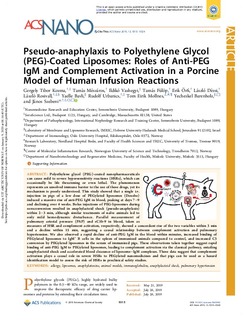| dc.contributor.author | Kozma, Gergely Tibor | |
| dc.contributor.author | Mészáros, Támas | |
| dc.contributor.author | Vashegyi, Ildikó | |
| dc.contributor.author | Fülöp, Tamás Gábor | |
| dc.contributor.author | Örfi, Erik | |
| dc.contributor.author | Dézsi, László | |
| dc.contributor.author | Rosivall, László | |
| dc.contributor.author | Bavli, Yaelle | |
| dc.contributor.author | Urbanics, Rudolf | |
| dc.contributor.author | Mollnes, Tom Eirik | |
| dc.contributor.author | Barenholz, Yechezkel | |
| dc.contributor.author | Szebeni, János | |
| dc.date.accessioned | 2020-01-15T07:48:00Z | |
| dc.date.available | 2020-01-15T07:48:00Z | |
| dc.date.created | 2019-10-20T16:39:01Z | |
| dc.date.issued | 2019 | |
| dc.identifier.citation | ACS Nano. 2019, 13 (8), 9315-9324. | nb_NO |
| dc.identifier.issn | 1936-0851 | |
| dc.identifier.uri | http://hdl.handle.net/11250/2636307 | |
| dc.description.abstract | Polyethylene glycol (PEG)-coated nanopharmaceuticals can cause mild to severe hypersensitivity reactions (HSRs), which can occasionally be life threatening or even lethal. The phenomenon represents an unsolved immune barrier to the use of these drugs, yet its mechanism is poorly understood. This study showed that a single i.v. injection in pigs of a low dose of PEGylated liposomes (Doxebo) induced a massive rise of anti-PEG IgM in blood, peaking at days 7–9 and declining over 6 weeks. Bolus injections of PEG-liposomes during seroconversion resulted in anaphylactoid shock (pseudo-anaphylaxis) within 2–3 min, although similar treatments of naı̈ve animals led to only mild hemodynamic disturbance. Parallel measurement of pulmonary arterial pressure (PAP) and sC5b-9 in blood, taken as measures of HSR and complement activation, respectively, showed a concordant rise of the two variables within 3 min and a decline within 15 min, suggesting a causal relationship between complement activation and pulmonary hypertension. We also observed a rapid decline of anti-PEG IgM in the blood within minutes, increased binding of PEGylated liposomes to IgM+ B cells in the spleen of immunized animals compared to control, and increased C3 conversion by PEGylated liposomes in the serum of immunized pigs. These observations taken together suggest rapid binding of anti-PEG IgM to PEGylated liposomes, leading to complement activation via the classical pathway, entailing anaphylactoid shock and accelerated blood clearance of liposome–IgM complexes. These data suggest that complement activation plays a causal role in severe HSRs to PEGylated nanomedicines and that pigs can be used as a hazard identification model to assess the risk of HSRs in preclinical safety studies. | nb_NO |
| dc.language.iso | eng | nb_NO |
| dc.publisher | American Chemical Society | nb_NO |
| dc.rights | Attribution-NonCommercial-NoDerivatives 4.0 Internasjonal | * |
| dc.rights.uri | http://creativecommons.org/licenses/by-nc-nd/4.0/deed.no | * |
| dc.title | Pseudo-anaphylaxis to polyethylene glycol (PEG)-coated liposomes: Roles of anti-PEG IgM and complement activation in a porcine model of human infusion reactions | nb_NO |
| dc.type | Journal article | nb_NO |
| dc.type | Peer reviewed | nb_NO |
| dc.description.version | publishedVersion | nb_NO |
| dc.source.pagenumber | 9315-9324 | nb_NO |
| dc.source.volume | 13 | nb_NO |
| dc.source.journal | ACS Nano | nb_NO |
| dc.source.issue | 8 | nb_NO |
| dc.identifier.doi | 10.1021/acsnano.9b03942 | |
| dc.identifier.cristin | 1738743 | |
| dc.description.localcode | This is an open access article published under a Creative Commons Attribution (CC-BY) License, which permits unrestricted use, distribution and reproduction in any medium, provided the author and source are cited. | nb_NO |
| cristin.unitcode | 194,65,15,0 | |
| cristin.unitname | Institutt for klinisk og molekylær medisin | |
| cristin.ispublished | true | |
| cristin.fulltext | original | |
| cristin.qualitycode | 1 | |

